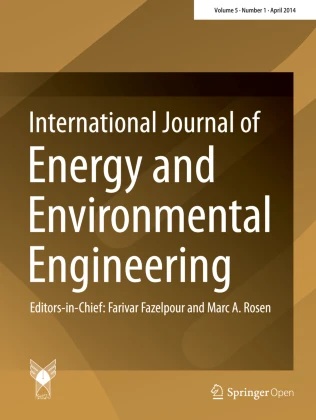Technical and economic feasibility assessment of low and high salinity water flooding: a simulation-based approach
- Mari Petroleum Company Limited, Islamabad, PK

Published in Issue 2023-01-05
How to Cite
Alvi, F., & Qureshi, H. A. (2023). Technical and economic feasibility assessment of low and high salinity water flooding: a simulation-based approach. International Journal of Energy and Environmental Engineering, 14(4 (December 2023). https://doi.org/10.1007/s40095-022-00556-8
Abstract
Abstract Waterflooding is renowned improved oil recovery method worldwide to recover medium to light crude oil. LSWF is an emergent IOR method which reduces the quantity of residual oil saturation by implementing waterfloods of low salt concentration. LSWF can increment the oil recovery up to 10–20% compared to simple waterflooding. A synthetic 3D simulation model is generated in this study using commercial black oil simulator (Eclipse 100). Two base cases of low and high salinity water flooding are simulated, and impact of low salinity water flooding on FOE, FOPR, FOPT, FPR, FSPR, FSPT is analyzed. Sensitivity analyses of injection water salinity, relative permeability curves, grid refinement, Low salinity slug size and end point saturation effects are also conducted (LASLTFNC). LSWF enhances the oil recovery efficiency by 17% compared to HSWF. Sensitivity of wettability (relative permeability curves) exhibits maximum recovery of 75.96% in presence of strongly water wet system. Similarly, sensitivity of grid refinement exhibits variation in ultimate recovery of 5.24% between LSWF base case and refined grid case. Sensitivity of injection water salinity from 1000 to 35,000 PPM (sea water) results in ultimate recovery between 60.88 and 75.96%, respectively. The continuous injection of LS water is not economical for whole production life therefore the injection of slug can help in the withdrawal of almost similar volume of oil with better cost. Economic analysis of five different LSWF cases and one HSWF case is carried out to evaluate the most economically viable injection scenario. From case-1 to case-6, injection of low salinity water for 450 days followed by high saline water turns out to be the most optimum case with NPV of 20.422 million dollars.Keywords
- Low salinity water flooding,
- EOR,
- Wettability alteration,
- Slug injection,
- Grid refinement recovery efficiency,
- Economic analysis
References
- Matsuo et al. (2013) A global energy outlook to 2035 with strategic considerations for Asia and Middle East energy supply and demand interdependencies 2(1) (pp. 79-91) https://doi.org/10.1016/j.esr.2013.04.002
- Chandrashegaran P.: Low salinity water injection for EOR. In: SPE Nigeria Annual International Conference and Exhibition (2015)
- Derkani et al. (2018) Low salinity waterflooding in carbonate reservoirs: review of interfacial mechanisms 2(2) https://doi.org/10.3390/colloids2020020
- Aladasani A, Bai B, Wu Y.S, Okasha Q.: 3D Simulation of low salinity, polymer, conventional, water-flooding & combination ior methods–heterogeneous and varying wetting conditions. In: SPE/IATMI Asia Pacific Oil and Gas Conference and Exhibition (2015)
- Muther et al. (2021) Unconventional hydrocarbon resources: geological statistics, petrophysical characterization, and field development strategies https://doi.org/10.1007/s13202-021-01404-x
- Muther et al. (2021) Socio-inspired multi-cohort intelligence and teaching-learning-based optimization for hydraulic fracturing parameters design in tight formations https://doi.org/10.1115/1.4052182
- VODE, P.O.P.O.O.: Performance of nano-filtration and reverse osmosis processes for wastewater treatment. Mater. Tehnol. 51(3) 541–548 (2017)
- Tang and Morrow (1999) Influence of brine composition and fines migration on crude oil/brine/rock interactions and oil recovery 24(2–4) (pp. 99-111) https://doi.org/10.1016/S0920-4105(99)00034-0
- Sharma and Filoco (2000) Effect of brine salinity and crude-oil properties on oil recovery and residual saturations 5(03) (pp. 293-300) https://doi.org/10.2118/65402-PA
- Snosy M.F, Abu El Ela M, El-Banbi A, Sayyouh H.: Comprehensive investigation of low salinity waterflooding in carbonate reservoirs. Journal of Petroleum Exploration and Production Technology.1–24 (2021)
- Mahmood et al. (2017) A sensitivity study on low salinity waterflooding (pp. 231-236) https://doi.org/10.15341/mese(2333-2581)/04.03.2017/003
- Al-Saedi et al. (2019) Eliminate the role of clay in sandstone: EOR low salinity water flooding 9(2) (pp. 1475-1483) https://doi.org/10.1007/s13202-018-0548-y
- LOW J.L.: LOW SALINITY WATER FLOODING SIMULATION STUDY (2013)
- Omekeh A.V, Friis H.A, Evje S. and Fjelde I.: A model for low salinity flooding experiments: dissolution and ion exchange. Journal of Porous Media 18 (3) (2015)
- Gbadamosi et al. (2022) Recent advances on the application of low salinity waterflooding and chemical enhanced oil recovery (pp. 9969-9996) https://doi.org/10.1016/j.egyr.2022.08.001
- Hasanov (2010) Norwegian University of Science and Technology
- Khan et al. (2021) Investigating the impact of injection-water salinity and well strategies on water mobility and oil production in an oil-wet reservoir 7(1) (pp. 247-260) https://doi.org/10.1007/s40808-020-00934-3
- Althani M.: An evaluation of low salinity waterflooding in carbonates using simulation and economics: colorado school of mines (2014)
- Afolabi et al. (2022) Polymeric surfactants for enhanced oil recovery: a review of recent progress https://doi.org/10.1016/j.petrol.2021.109358
- Aziz et al. (2021) A review on nanofluid water alternating gas (N-WAG): application, preparation, mechanism, and challenges 14(14) https://doi.org/10.1007/s12517-021-07787-9
- Syed F.I, Dahaghi A.K, Muther T.: Laboratory to field scale assessment for EOR applicability in tight oil reservoirs. Petroleum Science (2022)

 10.1007/s40095-022-00556-8
10.1007/s40095-022-00556-8











